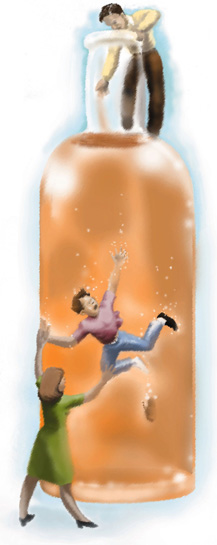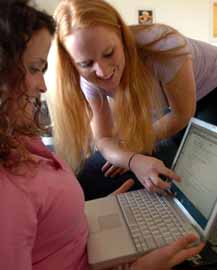Despite the stereotype of the world-weary, middle-age drunk, alcohol dependence often starts not in adulthood, but in adolescence.
“Youth have a much higher chance of addiction if they start drinking at a young age,” says Volkmann's mother, Chris. “Toren is a real good example of that.”
Together they wrote a new book, From Binge to Blackout: A Mother and Son Struggle with Teen Drinking .
Nearly half of people who suffered from alcohol dependence at some point in their life could have been diagnosed before age 21; two-thirds became dependent before age 25, says Ralph Hingson of the National Institute on Alcohol Abuse and Alcoholism. His study of 4,778 people was published this month in Pediatrics .
“Prevention becomes all the more important,” says Hingson, a professor at the Boston University School of Public Health.
Even as teen drinking continues to decline, it is still too high, and researchers keep finding more bad news. It's not like there weren't enough negatives already, with underage drinking long associated with a host of dangers, from car accidents to unprotected sex to general troublemaking. Now research also links it to ongoing health problems and even brain damage.
The still-developing adolescent brain “may be uniquely sensitive to alcohol's effects” notes another recent study in Alcohol Research & Health .
When researchers compared the effects of a four-day alcohol binge on the brains of adolescent and adult rats, they found “significant brain damage” in both. But it affected more parts of the adolescent brain, areas that weren't damaged in the adult rats, according to The Bowles Center for Alcohol Studies.
A 2005 survey found drinking among high-school seniors was at its lowest level since tracking began 20 years ago. Even so, nearly half had consumed alcohol in the prior month.
“Most parents consider alcohol benign,” says Toren. “It's not being talked about to the extent it should or could be.”
That might change: Their book, published in August by Penguin Group, has garnered national attention from People magazine, CBS Evening News and The New York Times . It's an updated version of their 2004 self-published book, Our Drink .
In alternating chapters, the two share their experiences and reactions as Toren sought treatment for alcoholism. In high school and then college, he frequently drank so much he blacked out. Despite getting kicked off sports teams and coming home falling-down drunk, his mom confesses, “We missed all the signs.” They punished him but, to Chris' lasting regret, didn't seek professional counseling.
Even if parents do catch a teen, most “have no idea of the extent of it - how many times [teens] are doing it and not getting caught,” says Toren, now 27 and living in San Diego, Calif.
Only one in five parents believes alcohol or marijuana is usually available at parties their teens attend, according to The National Center on Addiction and Substance Abuse's annual survey, released last month. But half of teen partygoers say illegal substances are readily at hand. Twice as many teens as parents (27 vs. 12 percent) cite drugs as their greatest concern.
Many parents are astounded to learn how much some students consume, Chris says.
In Washington state, 1 in 10 eighth-grade students admitted binge drinking (generally defined as five drinks in one sitting) in the previous two weeks, according to the 2004 Healthy Youth Survey of 30,000 students. That percentage jumped to nearly 1 in 5 for sophomores and 1 in 4 for seniors.
In college, some young adults pass the five-drink threshold two or even three times in an evening.
“Extreme drinking almost becomes like a sport to kids,” Toren says. “They try to act the craziest and do the funniest stuff. It's never seen as something that could lead to something bad.”
© 2006, The Seattle Times.
Distributed by McClatchy-Tribune Information Services.




